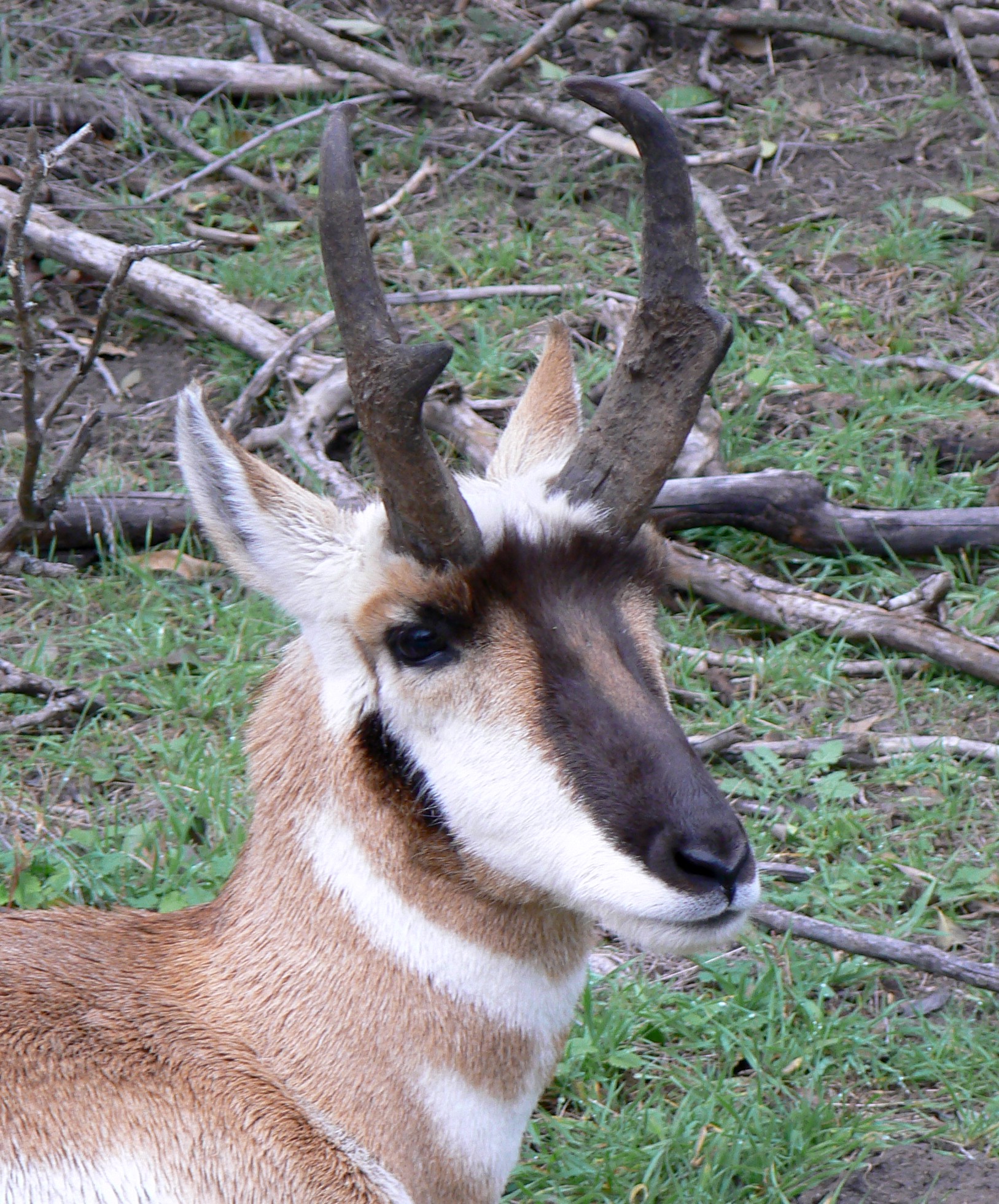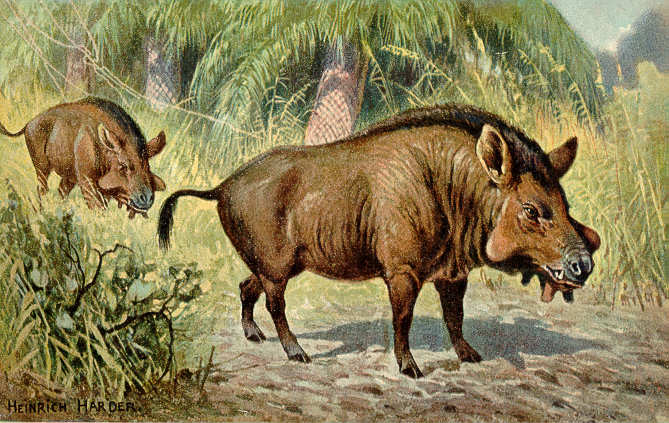|
Tetrameryx
''Tetrameryx'' is an extinct genus of the North American artiodactyl family Antilocapridae, known from Mexico, the western United States, and Saskatchewan Saskatchewan ( ; ) is a province in western Canada, bordered on the west by Alberta, on the north by the Northwest Territories, on the east by Manitoba, to the northeast by Nunavut, and on the south by the U.S. states of Montana and North .... The name means "four ornedruminant", referring to the division of each horn near its base into two prongs; in ''T. shuleri'', the rear prong is much longer. One member of the genus, ''T. shuleri'', survived until about 12,000 years ago, and was present when Paleo-Indians reached North America. Although approximately the same size as the living pronghorn, the limb bones are somewhat more robust, suggesting that its running speed was slower than living pronghorn. References Prehistoric pronghorns Prehistoric even-toed ungulate genera Extinct mammals of North America ... [...More Info...] [...Related Items...] OR: [Wikipedia] [Google] [Baidu] |
Antilocapridae
The Antilocapridae are a family of artiodactyls endemic to North America. Their closest extant relatives are the giraffids with which they comprise the superfamily Giraffoidea. Only one species, the pronghorn (''Antilocapra americana''), is living today; all other members of the family are extinct. The living pronghorn is a small ruminant mammal resembling an antelope. Description In most respects, antilocaprids resemble other ruminants. They have a complex, four-chambered stomach for digesting tough plant matter, cloven hooves, and small, forked horns. Their horns resemble those of the bovids, in that they have a true horny sheath, but, uniquely, they are shed outside the breeding season, and subsequently regrown. Their lateral toes are even further diminished than in bovids, with the digits themselves being entirely lost, and only the cannon bones remaining. Antilocaprids have the same dental formula as most other ruminants: . Classification The antilocaprids are r ... [...More Info...] [...Related Items...] OR: [Wikipedia] [Google] [Baidu] |
Pronghorn
The pronghorn (, ) (''Antilocapra americana'') is a species of artiodactyl (even-toed, hoofed) mammal indigenous to interior western and central North America. Though not an antelope, it is known colloquially in North America as the American antelope, prong buck, pronghorn antelope and prairie antelope, because it closely resembles the antelopes of the Old World and fills a similar ecological niche due to parallel evolution. It is the only surviving member of the family Antilocapridae. During the Pleistocene epoch, about 11 other antilocaprid species existed in North America.Smithsonian Institution. North American MammalsPronghorn ''Antilocapra americana''/ref> Three other genera ('' Capromeryx'', ''Stockoceros'' and '' Tetrameryx'') existed when humans entered North America but are now extinct. As a member of the superfamily Giraffoidea, the pronghorn's closest living relatives are the giraffe and okapi. See Fig. S10 in Supplementary Information. The Giraffoidea are in ... [...More Info...] [...Related Items...] OR: [Wikipedia] [Google] [Baidu] |
Paleobiology Database
The Paleobiology Database is an online resource for information on the distribution and classification of fossil animals, plants, and microorganisms. History The Paleobiology Database (PBDB) originated in the NCEAS-funded Phanerozoic Marine Paleofaunal Database initiative, which operated from August 1998 through August 2000. From 2000 to 2015, PBDB received funding from the National Science Foundation. PBDB also received support form the Australian Research Council. From 2000 to 2010 it was housed at the National Center for Ecological Analysis and Synthesis, a cross-disciplinary research center within the University of California, Santa Barbara. It is currently housed at University of Wisconsin-Madison and overseen by an international committee of major data contributors. The Paleobiology Database works closely with the Neotoma Paleoecology Database, which has a similar intellectual history, but has focused on the Quaternary (with an emphasis on the late Pleistocene and Holoc ... [...More Info...] [...Related Items...] OR: [Wikipedia] [Google] [Baidu] |
Richard Swann Lull
Richard Swann Lull (November 6, 1867 – April 22, 1957) was an American paleontologist and Sterling Professor at Yale University who is largely remembered now for championing a non-Darwinian view of evolution, whereby mutation(s) could unlock presumed "genetic drives" that, over time, would lead populations to increasingly extreme phenotypes (and perhaps, ultimately, to extinction). Life Lull was born in Annapolis, Maryland, the son of naval officer Edward Phelps Lull and Elizabeth Burton, daughter of General Henry Burton. He married Clara Coles Boggs and he has a daughter Dorothy. He majored in zoology at Rutgers College where he received both his undergraduate and master's degrees (M.S. 1896). He worked for the Division of Entomology of the United States Department of Agriculture, but in 1894 became an assistant professor of zoology at the State Agricultural College in Amherst, Massachusetts (now the University of Massachusetts Amherst). Lull's interest in fossi ... [...More Info...] [...Related Items...] OR: [Wikipedia] [Google] [Baidu] |
Ruben A
Reuben or Reuven is a Biblical male first name from Hebrew רְאוּבֵן (Re'uven), meaning "behold, a son". In the Bible, Reuben was the firstborn son of Jacob. Variants include Rúben in European Portuguese; Rubens in Brazilian Portuguese; Rubén in Spanish; Rubèn in Catalan; Ruben in Dutch, German, French, Italian, Swedish, Norwegian, Danish, and Armenian; and Rupen/Roupen in Western Armenian. The form Ruben can also be a form of the name Robin, itself a variation of the Germanic name Robert in several Celtic languages. It preserves the "u" sound from the name's first component "hruod" (compare Ruairí, the Irish form of Roderick). Mononym * Ruben I, Prince of Armenia (1025/1035 – 1095), the first lord of Armenian Cilicia or "Lord of the Mountains" from 1080/1081/1082 to 1095, founder of Rubenid dynasty * Ruben II, Prince of Armenia (c. 1165 – 1170), the seventh lord of Armenian Cilicia or "Lord of the Mountains" from 1169 to 1170 * Ruben III, Princ ... [...More Info...] [...Related Items...] OR: [Wikipedia] [Google] [Baidu] |
Walter W
Walter may refer to: People * Walter (name), both a surname and a given name * Little Walter, American blues harmonica player Marion Walter Jacobs (1930–1968) * Gunther (wrestler), Austrian professional wrestler and trainer Walter Hahn (born 1987), who previously wrestled as "Walter" * Walter, standard author abbreviation for Thomas Walter (botanist) ( – 1789) Companies * American Chocolate, later called Walter, an American automobile manufactured from 1902 to 1906 * Walter Energy, a metallurgical coal producer for the global steel industry * Walter Aircraft Engines, Czech manufacturer of aero-engines Films and television * ''Walter'' (1982 film), a British television drama film * Walter Vetrivel, a 1993 Tamil crime drama film * ''Walter'' (2014 film), a British television crime drama * ''Walter'' (2015 film), an American comedy-drama film * ''Walter'' (2020 film), an Indian crime drama film * '' W*A*L*T*E*R'', a 1984 pilot for a spin-off of the TV series ''M*A*S*H ... [...More Info...] [...Related Items...] OR: [Wikipedia] [Google] [Baidu] |
Genus
Genus ( plural genera ) is a taxonomic rank used in the biological classification of living and fossil organisms as well as viruses. In the hierarchy of biological classification, genus comes above species and below family. In binomial nomenclature, the genus name forms the first part of the binomial species name for each species within the genus. :E.g. '' Panthera leo'' (lion) and '' Panthera onca'' (jaguar) are two species within the genus ''Panthera''. ''Panthera'' is a genus within the family Felidae. The composition of a genus is determined by taxonomists. The standards for genus classification are not strictly codified, so different authorities often produce different classifications for genera. There are some general practices used, however, including the idea that a newly defined genus should fulfill these three criteria to be descriptively useful: # monophyly – all descendants of an ancestral taxon are grouped together (i.e. phylogenetic analysis should c ... [...More Info...] [...Related Items...] OR: [Wikipedia] [Google] [Baidu] |
Artiodactyla
The even-toed ungulates (Artiodactyla , ) are ungulates—hoofed animals—which bear weight equally on two (an even number) of their five toes: the third and fourth. The other three toes are either present, absent, vestigial, or pointing posteriorly. By contrast, odd-toed ungulates bear weight on an odd number of the five toes. Another difference between the two is that many other even-toed ungulates (with the exception of Suina) digest plant cellulose in one or more stomach chambers rather than in their intestine as the odd-toed ungulates do. Cetaceans (whales, dolphins, and porpoises) evolved from even-toed ungulates, and are therefore often classified under the same taxonomic branch because a species cannot outgrow its evolutionary ancestry; some modern taxonomists combine the two under the name Cetartiodactyla , while others opt to include cetaceans in the already-existing Artiodactyla. The roughly 270 land-based even-toed ungulate species include pigs, peccaries, hippop ... [...More Info...] [...Related Items...] OR: [Wikipedia] [Google] [Baidu] |
Saskatchewan
Saskatchewan ( ; ) is a province in western Canada, bordered on the west by Alberta, on the north by the Northwest Territories, on the east by Manitoba, to the northeast by Nunavut, and on the south by the U.S. states of Montana and North Dakota. Saskatchewan and Alberta are the only landlocked provinces of Canada. In 2022, Saskatchewan's population was estimated at 1,205,119. Nearly 10% of Saskatchewan’s total area of is fresh water, mostly rivers, reservoirs and lakes. Residents primarily live in the southern prairie half of the province, while the northern half is mostly forested and sparsely populated. Roughly half live in the province's largest city Saskatoon or the provincial capital Regina. Other notable cities include Prince Albert, Moose Jaw, Yorkton, Swift Current, North Battleford, Melfort, and the border city Lloydminster. English is the primary language of the province, with 82.4% of Saskatchewanians speaking English as their first language. Saska ... [...More Info...] [...Related Items...] OR: [Wikipedia] [Google] [Baidu] |
The American Journal Of Science (1921) (17964315139)
''The'' () is a grammatical article in English, denoting persons or things that are already or about to be mentioned, under discussion, implied or otherwise presumed familiar to listeners, readers, or speakers. It is the definite article in English. ''The'' is the most frequently used word in the English language; studies and analyses of texts have found it to account for seven percent of all printed English-language words. It is derived from gendered articles in Old English which combined in Middle English and now has a single form used with nouns of any gender. The word can be used with both singular and plural nouns, and with a noun that starts with any letter. This is different from many other languages, which have different forms of the definite article for different genders or numbers. Pronunciation In most dialects, "the" is pronounced as (with the voiced dental fricative followed by a schwa) when followed by a consonant sound, and as (homophone of the archaic pro ... [...More Info...] [...Related Items...] OR: [Wikipedia] [Google] [Baidu] |
Prehistoric Pronghorns
Prehistory, also known as pre-literary history, is the period of human history between the use of the first stone tools by hominins 3.3 million years ago and the beginning of recorded history with the invention of writing systems. The use of symbols, marks, and images appears very early among humans, but the earliest known writing systems appeared 5000 years ago. It took thousands of years for writing systems to be widely adopted, with writing spreading to almost all cultures by the 19th century. The end of prehistory therefore came at very different times in different places, and the term is less often used in discussing societies where prehistory ended relatively recently. In the early Bronze Age, Sumer in Mesopotamia, the Indus Valley Civilisation, and ancient Egypt were the first civilizations to develop their own scripts and to keep historical records, with their neighbors following. Most other civilizations reached the end of prehistory during the following Iron Age. ... [...More Info...] [...Related Items...] OR: [Wikipedia] [Google] [Baidu] |
_(17964315139).jpg)





.png)
